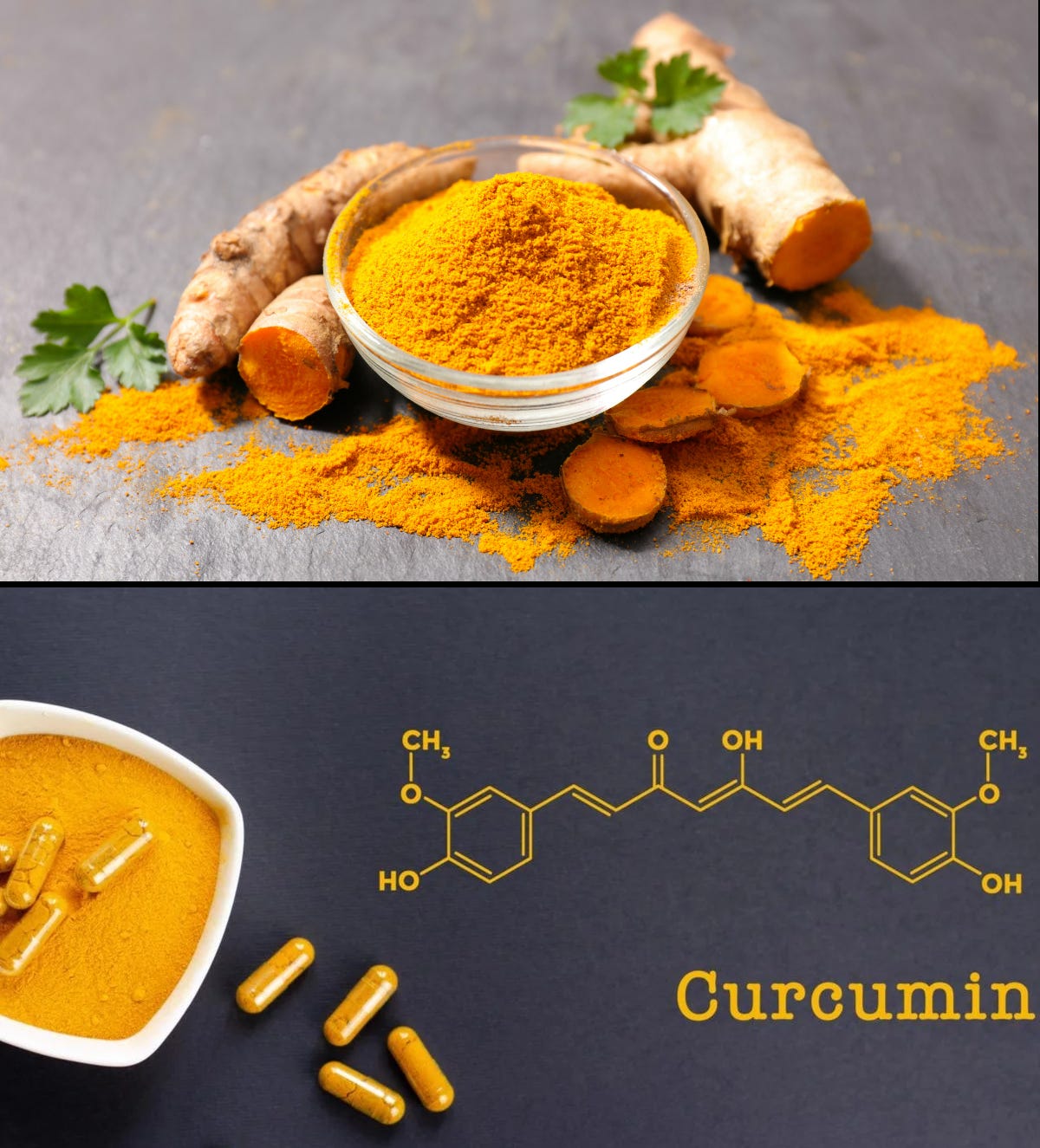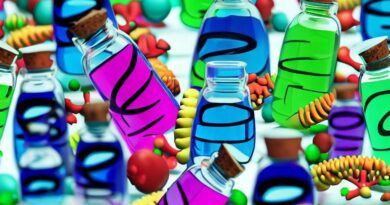COVID-19 mRNA Vaccine Injury Treatment: Curcumin (Turmeric) Blocks Spike Protein (Combine It with Bromelain), Treats Myocarditis, Has Anti-inflammatory, Anti-aging and Anti-Cancer Properties!
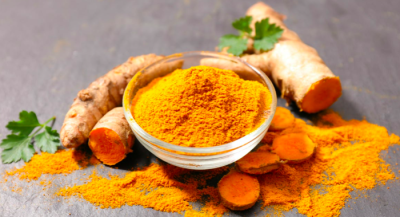
Curcumin (diferuloylmethane), is a main bioactive polyphenolic compound that is extracted from the Curcuma longa (Tumeric) rhizomes, which belongs to Ginger family and is broadly cultivated in Southeast Asia and India.
Curcumin is a yellowish compound, which has been used as a food additive, dietary spice, and herbal remedy.
Several investigations have revealed that curcumin possesses potent biochemical and biological activities, including anti-inflammatory, anti-viral, anti-bacterial antioxidant, and anti-cancer activities.
In traditional herbal medicine, curcumin is used to improve the immune system and as a treatment for various respiratory disorders like allergy and asthma.
Curcumin has also been traditionally used for the treatment of numerous diseases including ulcers, dysentery, jaundice, upset stomach, arthritis, acne, wounds, and eye and skin infections.
May 2020 – Zahediour et al reviewed curcumin in COVID-19 infection:
- curcumin has antiviral properties against other viruses like RSV, Herpes
- curcumin altered surface protein structure of viruses to block their entry into cells
- curcumin binds spike protein (!)
- curcumin inhibits viral replication inside infected cells
- curcumin inhibits inflammatory cytokines in COVID infection and decreases cytokine storm
- curcumin inhibits oxidative stress that causes severe lung injuries
- curcumin inhibits fibrotic response in COVID-19 infection, reduces lung fibrosis, reduces cardiac damage and fibrosis, reduces kidney fibrosis
July 2022 – Nag et al. found that curcumin had strong, stable binding with Omicron spike protein, that was superior to hydroxychloroquine. It could also disrupt a spike protein already bound to ACE-2.
Sep.2022 – Zipin et al found that curcumin can disrupt Omicron viral particles but their curcumin formulation which had poor bioavailability, was unable to disrupt Omicron virus in infected cells – authors suggest using nanocurcumin to improve bioavailability
Oct.2022 – Venugopa et al. found that in addition to curcumin binding spike protein, curcumin could also interfere with COVID-19 viral replication, and was an immunomodulator that could prevent cytokine storm.
April 2023 – Wei Wu et al. found that curcumin could ameliorate spike protein mediated oxidative stress through scavenging ROS (reactive oxygen species) and enhancing function of the antioxidation system. This is enhanced further when taken in combination with resveratrol.
Greek researchers Kritis et al showed in Dec.2020 that Bromelain combined with Curcumin has a major impact on stopping severe COVID-19!
- Severe COVID-19 involves 3 pathways: inflammatory (cytokine storm), coagulation (thrombosis) and bradykinin cascades
- Both Bromelain and Curcumin inhibit two of these (inflammation and coagulation) and Bromelain inhibits bradykinin as well.
- Both Bromelain and Curcumin block binding of spike protein to ACE-2 and TMPRSS-2
- Bromelain also increases absorption of curcumin after oral intake which is very important because curcumin on its own has very poor bioavailability
- Conclusion: “Bromelain is absorbed directly when administered orally, while it substantially promotes the absorption of curcumin enhancing its bioavailability,and making this a perfect combination of immune-boosting nutraceuticals with synergistic anti-inflammatory and anticoagulant actions”
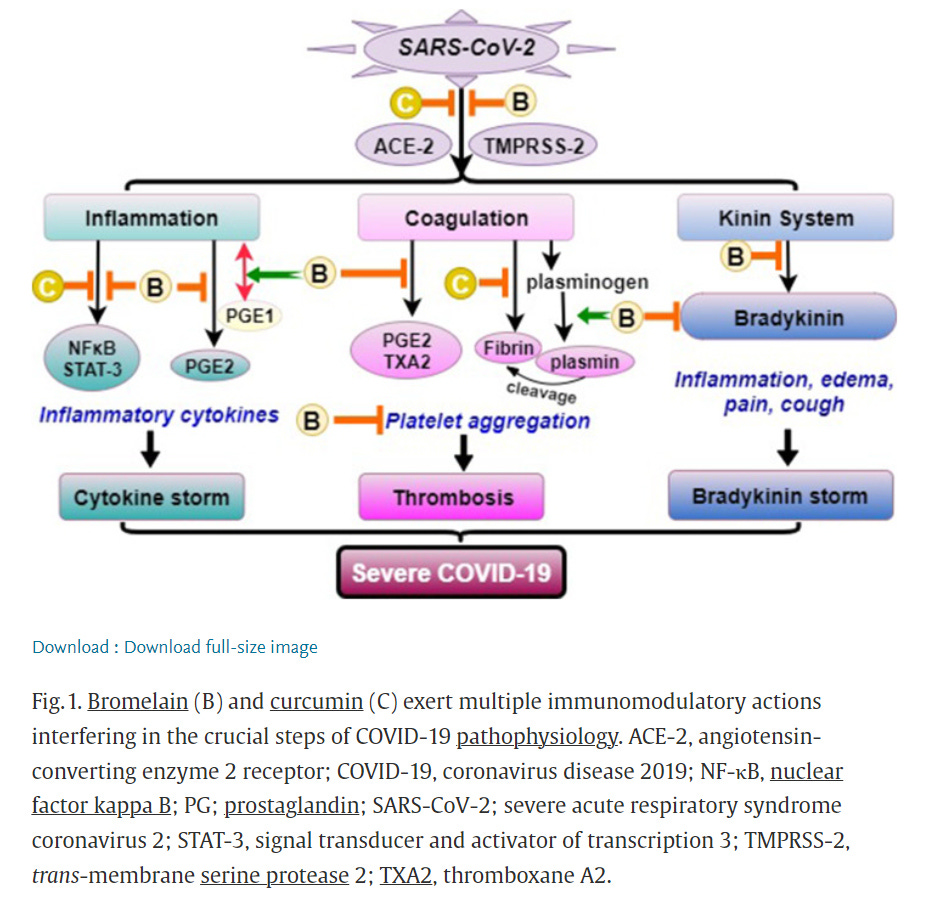
Aging is one of the most complex and intricate phenomenon in the biological context. Aging is described as a physiological decrease of several biological activities in the organ with a gradual reduction of cellular adjustment to external and internal injuries.
The senescence that is known also as cellular aging is the hallmark of aging, and includes the reduction of the regenerative capacity of cells. In this regard, cellular senescence seems to be harmful because it consists of a defect of tissue renewal and functionality. Cellular senescence is an irreversible growth arrest by which cells cease to replicate; it occurs in somatic cells and limits their proliferative life span.
Anti-aging benefits of Curcumin:
- 10 times higher anti-oxidant activity compared to Vitamin E
- Stimulates production of anti-oxidative enzymes (like superoxide dismutase) that decrease oxidative stress and increase life span
- Inhibits lipid peroxidation
- free radical scavenging activities slow telomere shortening
- activates various cell signaling pathways that increase lifespan
- decreases inflammation in neural cells, decreases neurodegenerative processes
- decreases skin aging, promotes wound healing
- inhibits aging processes in skeletal muscle, improves muscle mass and function
- powerful anti-cancer effects by inducing apoptosis of cancer cells
- Aug. 2021 – Zoi et al – summarized curcumin’s effects on cancer

- Lung cancer: curcumin suppressed invasion and metastatic potential of lung cancer cells. Also activates key tumor suppressor genes in smoking induced lung cancer
- breast cancer: curcumin stopped the growth of breast cancer cells, also suppressed invasion and metastasis of breast cancer cells
- prostate cancer: curcumin induced apoptosis and autophagy of cancer cells and is effective in castration-resistant prostate cancer as well
- brain cancer: nanocurcumin can get past BBB into brain and can decrease proliferation of glioblastoma (GBM) cells, also suppresses formation of GBM stem cells which are responsible for tumor progression, recurrence and resistance to chemo – curcumin also decreases malignant characteristics of GBM stem cells to prevent GBM cancer recurrence.
- pancreatic cancer: curcumin suppresses formation of cancer stem cells which are responsible for high proliferation rate and rapid tumor growth of pancreatic cancer – suppresses tumor growth.
- leukemia – curcumin affects numerous anti-cancer pathways, also enhances the effectiveness of chemo in treatment of leukemias.
- Feb.2021 – Zia et al – most cancers have a non-functional or mutated p53 tumor suppressor gene
- curcumin activates p53 pathway that induces senescence in cancerous cells and also induces death of cancer cells via apoptosis
- Aug.2020 – Mansouri et al reviews use of curcumin in cancer patients:
- curcumin increases effectiveness of chemo and radiation therapy
- curcumin improves patient survival and increases expression of anti-metastatic proteins
- curcumin reduces side effects of chemotherapy and radiotherapy
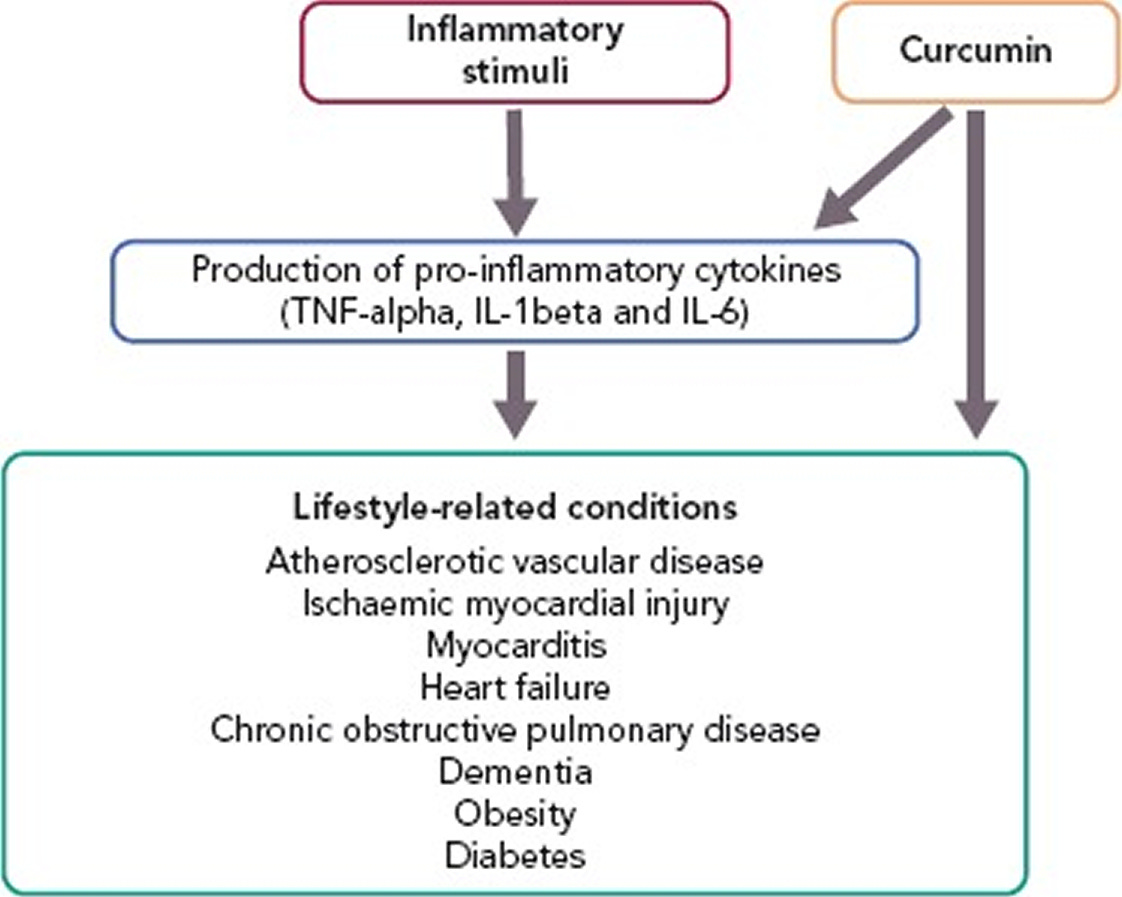
- curcumin reduces myocardial infarct size
- curcumin treats myocarditis(!) reduces inflammation and progression
- curcumin inhibits development of left ventricular systolic dysfunction and heart failure
- curcumin reduces lung inflammation in COPD
- obesity – curcumin reduces inflammation due to obesity, also improves serum lipid profile and lipid metabolism.
- dementia – nanocurcumin reduced amyloid and tau accumulation in the brain
- Oct.2021 – Tabanelli et al reported that the major problem with curcumin is low bioavailability
- curcumin is almost insoluble in pure water
- curcumin has poor absorption, fast metabolism and rapid systemic clearance resulting in very low curcumin levels in plasma and tissues
- some formulations have curcumin + black pepper (piperine) which blocks the breakdown of curcumin.
- there are “nanocurcumin” formulations that enhance absorption and bioavailability
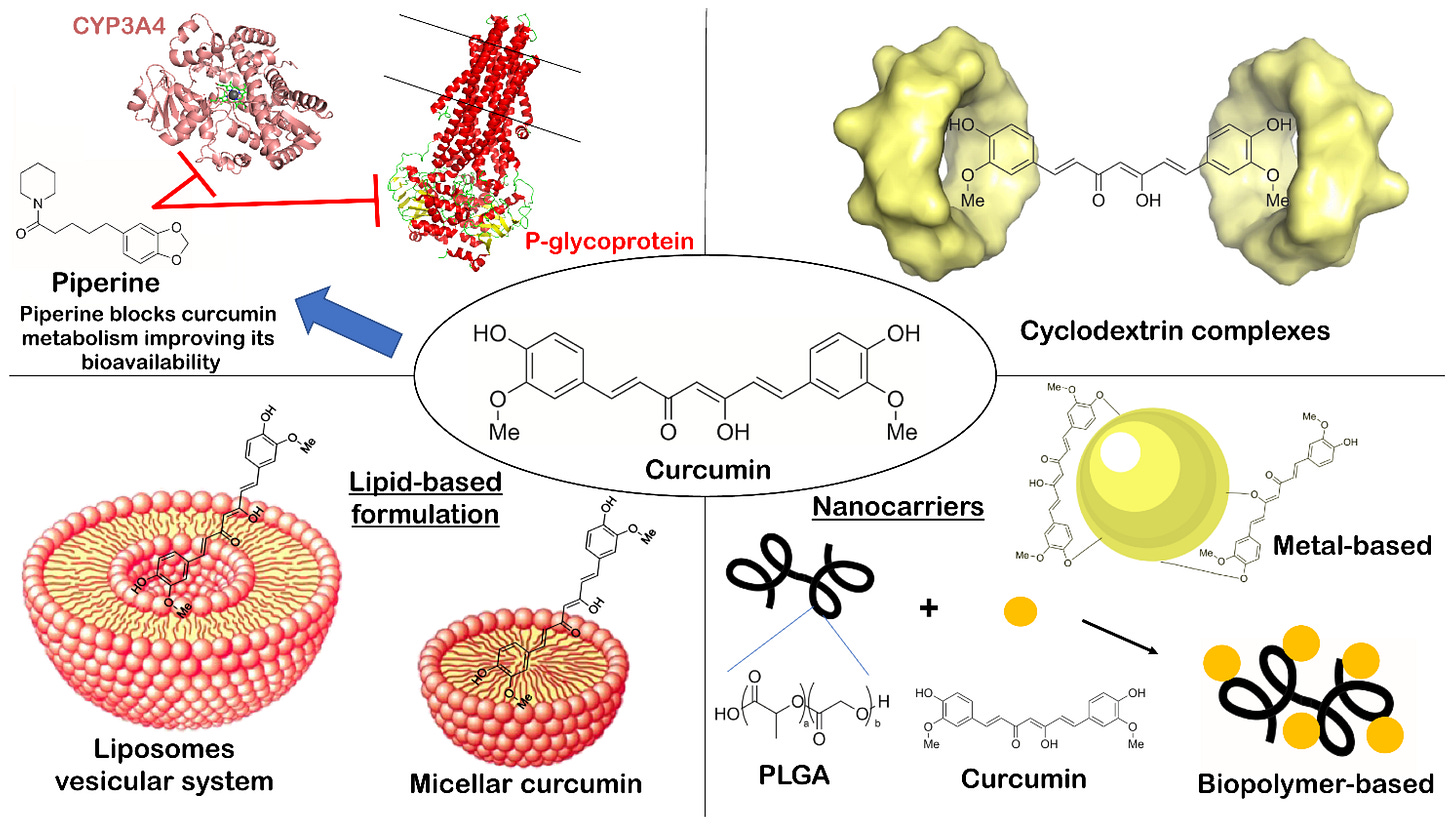
Curcumin has been characterized as “generally safe” by the US Food and Drug Administration (FDA). Indeed, no significant side effects related to curcumin can be found in the literature. Some of the documented cases are of reversible side effects, including allergic dermatitis.
Dose-escalating studies have demonstrated that consumption of up to 12 g of curcumin daily presents no damaging effects. In studies on patients with solid tumors, no adverse effects were reported when curcumin was given for 8 weeks at a dosage of 900 mg/day orally, except for mild gastrointestinal upset.
Oral intake of 6 g/day of curcumin for 7 weeks was also reported to be safe in patients with breast cancer, and 3 g/day of curcumin given for 9 weeks to patients with prostate cancer showed no adverse effects.
Curcumin also exhibits a strong iron-chelating activity. Long-term supplementation with curcumin induced iron depletion in young mice.
Apart from that, curcumin possesses anticoagulant properties and may increase bleeding time in patients receiving anticoagulants.
It has been reported that this compound can inhibit several cytochrome P450 subtypes, including CYP2C9 and CYP3A4. For this reason, curcumin has been known to interact with certain other medications, including anticoagulants, antibiotics and antidepressants.
How can the COVID-19 Vaccine Injured or Long COVID patients benefit from Curcumin?
First, get a highly absorbable formulation: nanocurcumin, Curcumin + Bromelain or Curcumin + Black Pepper (piperine – which blocks the breakdown of curcumin and increases bioavailability).
There is no point taking a regular curcumin supplement with poor absorption
- binds spike protein (stronger binding than hydroxychloroquine)
- reduces tissue damage done by spike protein (decreases oxidative stress)
- protects against COVID infection and re-infection (disrupts viruses, blocks their replication, reduces cytokine storm, reduces lung edema & inflammation)
- reduces fibrosis in the lungs, heart, kidneys caused by spike protein
- treats myocarditis (!) (has many anti-inflammatory effects which are very useful in anyone suffering from “lifestyle conditions” including obesity, diabetes and cardiovascular disease)
- anti-aging benefits – 10x higher antioxidant than Vitamin E, slows telomere shortening, decreases neurodegenerative processes, decreases skin aging, decreases skeletal muscle aging, anti-tumor effects
- powerful anti-cancer effects
- stops growth of breast cancer, lung cancer, prostate cancer cells
- stimulates autophagy and apoptosis of cancer cells
- suppresses malignant cell invasion & metastasis
-
POTENTIAL TURBO CANCER EFFECTS:
- stimulates p53 tumor suppressor pathways which may have been damaged by the spike protein
- for aggressive cancers like glioblastomas and pancreatic cancers – it suppresses formation of cancer stem cells that are responsible for aggressive growth, spread, recurrence and resistance to chemo.
- leukemias – has many pathways to treat leukemias.
-
enhances effectiveness of chemotherapy and radiation therapy and decreases their side effects (may be helpful for COVID-19 vaccine induced turbo cancer patients whose cancers are resistant to conventional chemo and radiation)
*
Note to readers: Please click the share button above. Follow us on Instagram and Twitter and subscribe to our Telegram Channel. Feel free to repost and share widely Global Research articles.
Dr. William Makis is a Canadian physician with expertise in Radiology, Oncology and Immunology. Governor General’s Medal, University of Toronto Scholar. Author of 100+ peer-reviewed medical publications.
 The Worldwide Corona Crisis, Global Coup d’Etat Against Humanity
The Worldwide Corona Crisis, Global Coup d’Etat Against Humanity
by Michel Chossudovsky
Michel Chossudovsky reviews in detail how this insidious project “destroys people’s lives”. He provides a comprehensive analysis of everything you need to know about the “pandemic” — from the medical dimensions to the economic and social repercussions, political underpinnings, and mental and psychological impacts.
“My objective as an author is to inform people worldwide and refute the official narrative which has been used as a justification to destabilize the economic and social fabric of entire countries, followed by the imposition of the “deadly” COVID-19 “vaccine”. This crisis affects humanity in its entirety: almost 8 billion people. We stand in solidarity with our fellow human beings and our children worldwide. Truth is a powerful instrument.”
ISBN: 978-0-9879389-3-0, Year: 2022, PDF Ebook, Pages: 164, 15 Chapters
Price: $11.50 FREE COPY! Click here (docsend) and download.
We encourage you to support the eBook project by making a donation through Global Research’s DonorBox “Worldwide Corona Crisis” Campaign Page.
This article has been archived for your research. The original version from Global Research can be found here.
